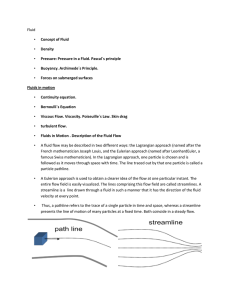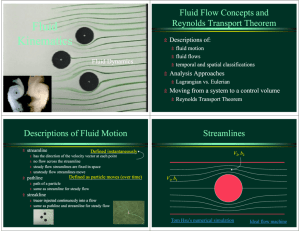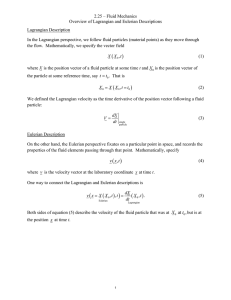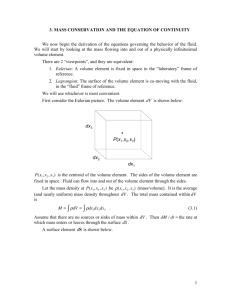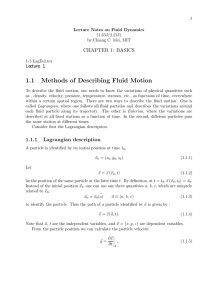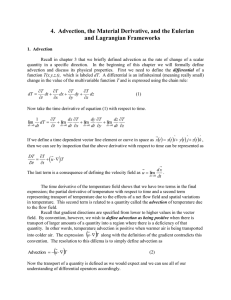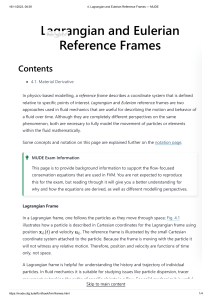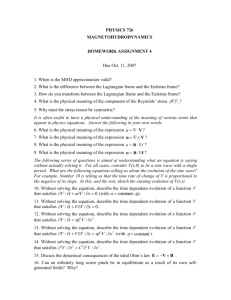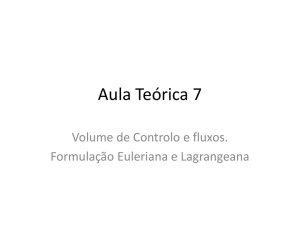Chapter 4 Fluid Kinematics
advertisement
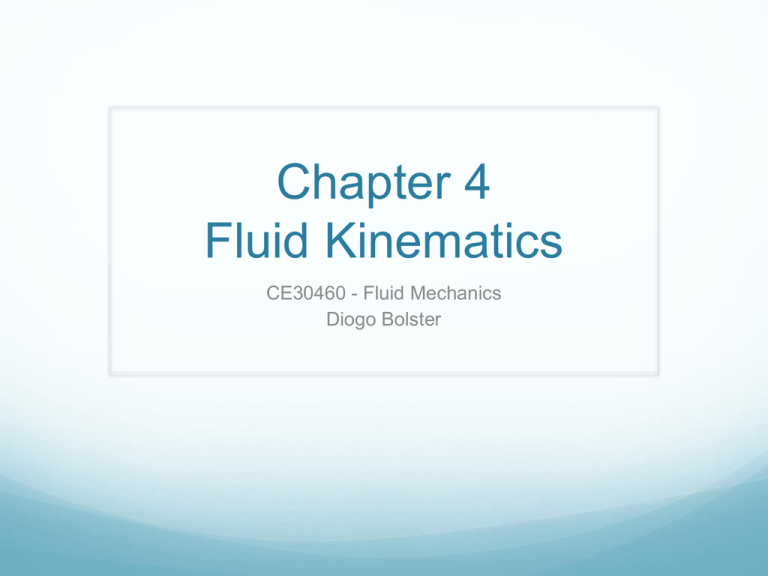
Chapter 4 Fluid Kinematics CE30460 - Fluid Mechanics Diogo Bolster Velocity Field How could you visualize a velocity field in a real fluid? Streamlines, Steaklines and Pathlines A streamline is a line that is everywhere tangent to the velocity field – dy/dx=v/u (governing equation) A streakline consists of all particles in a flow that have previously passed through a common point A pathline is the line traced out by a given particle as it flows For a steady flow they are all the same. For an unsteady flow they are not. Example https://engineering.purdue.edu/~wassgren/applet/java/fl owvis/ http://wwwmdp.eng.cam.ac.uk/web/library/enginfo/aerothermal_d vd_only/aero/fprops/cvanalysis/node8.html Look at these yourself – we will demonstrate an example using Matlab in a few slides. Streamlines Streamlines around a Nascar Streaklines Pathlines Example Problem Flow Above an Oscillating Plate with a vertical blowing is given by u = e -y cos(t - y) v =1 Draw the streamlines at various times Draw pathlines Draw streaklines Compare to the steady case where See Matlab code u = e -y cos(-y) Eulerian vs. Lagrangian Perpsective Eulerian Sit and observe a fixed area from a fixed point Lagrangian Travel with the flow and observe what happens around you Mixed – something that sits between the two Eulerian vs. Lagrangian Perpsective Eulerian vs. Lagrangian Perpsective – Which is which? Experimental Measurements Fixed Measurement System A floating gauge The Material Derivative Consider a fluid particle moving along its pathline (Lagrangian system) The velocity of the particle is given by It depends on the x,y, and z position of the particle Acceleration aA=dVA/dt • It is tough to calculate this, but if we have an Eulerian picture…… The Material Derivative The material derivative (you can see it called the substantial derivative too) relates Lagrangian and Eulerian viewpoints and is defined as Or in compact notation The Material Derivative Unsteady local Time derivative Convective Effects Example – convection of heat or a contaminant…. Control Volumes A system is a collection of matter of fixed identity (always the same packets) A Control Volume (CV) is a volume in space through which fluid can flow (it can be Lagrangian, i.e. moving and deforming with flow or Eulerian, i.e. fixed in space) CVs can be fixed, mobile, flexible, etc. All laws in continuum mechanics depart from a CV analysis (i.e. balance mass, momentum, energy etc in a sufficiently small control volume). Sample Problem to distinguish System from Control Volume Control Volumes Reynolds Transport Theorem A tool to relate system concepts to control volume concepts Let B be a fluid parameter (e.g. mass, temperature, momentum) Let b represent the amount of that parameter per unit mass e.g. Momentum B=mV => b=V Energy B=1/2mV2 => b=1/2 V2 Reynolds Transport Theorem Reynolds Transport Theorem Generally written as Sample Problem Sample Problem
